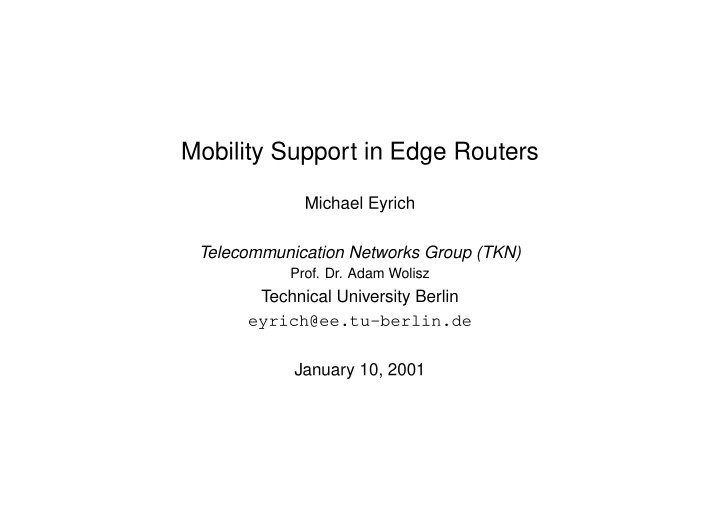



Mobility Support in Edge Routers Michael Eyrich Telecommunication Networks Group (TKN) Prof. Dr. Adam Wolisz Technical University Berlin eyrich@ee.tu-berlin.de January 10, 2001
Outline WUGS • Quo vadis, DFN project? • Aims of the DFN testbed • Service platforms • Remote Socket Architecture (ReSoA) • Local testbed • Last Hop Protocol: LLP • Support Tool for test environment c � 2001 · Mobility Support in Edge Routers 1 TKN
Quo vadis, DFN project? WUGS General project description • potentialities and limits of a simple approach for Active networking • application-specific services, specifically mobility – terminal mobility – personal mobility → flexible service platform e.g., transport protocols for group communication Areas of application • group- and mobile communication – proving – evaluation • analysis – quality of service – safety – reliability c � 2001 · Mobility Support in Edge Routers 2 TKN
Aims of the DFN testbed WUGS Aims • prototypic realizations • experiences in terms of testbed – appropriation – use of a flexible open service platform Steps 1. GNU/Linux based PCs with flexible open service platform 2. Extension to high bandwidth IP over WDM (on top or parallel to DFN network). 3. Opening to a broader range of users c � 2001 · Mobility Support in Edge Routers 3 TKN
Service platforms WUGS Service platforms • AMnet (Active Multicasting Network) • ANN (Active Network Nodes) based on WUGS (Washington University Gigabit Switch) • Router Plug-ins Desired results • conclusions on necessary functionality • cycling through steps of → conception → realization → evaluation c � 2001 · Mobility Support in Edge Routers 4 TKN
Remote Socket Architecture (ReSoA) WUGS wireless end−system base station distant end−system application application user user interface interface Export Protocol Local Socket Module Export Socket Server socket interface exchange commandsand results TCP TCP LHP LHP IP IP WLAN WLAN LAN LAN Internet SPC? c � 2001 · Mobility Support in Edge Routers 5 TKN
ReSoA (cont.) WUGS ReSoA • Remote Socket Architecture, consisting of: • Export Protocol: – transport layer proxy approach – Transfer of socket functionality • Last Hop Protocol (LHP): e.g., Link Layer Protocol – reliable transmission for TCP streams – semi-reliable transmission for UDP streams – implemented for GNU/Linux – implemented as virtual devices allowing for dynamically interchanging protocols. • between edge router and mobile node Open issues • porting to ⋆ BSD-ish environment? • porting Export Protocol to current Linux kernel version (from 2.0.x to 2.2.x or 2.4.x) c � 2001 · Mobility Support in Edge Routers 6 TKN
Last Hop Protocol: LLP WUGS Implementation of LLP • Support layer for MAC protocols • Reduction of unnecessary multi-hop retransmissions • Device independent (tested with ethernet and several wireless devices) • packet path controlled by standard routing rules • additional internal refinement (e.g., by ports) to improve transmission reliability for selected applications (e.g., NFS) Schematic display tcp tcp udp udp ip ip llp llp unreliable unreliable reliable reliable wvlan eth c � 2001 · Mobility Support in Edge Routers 7 TKN
Local Testbed WUGS WUGS 41/42 51/52 145 PC4 SPC/Port4 SPC/Port5 PC5 192.168.40.10 192.168.40.1 192.168.50.1 192.168.50.10 145 100 100 146 146 156 156 SPC/Port6 192.168.60.1 61/62 100 PC6 192.168.60.10 c � 2001 · Mobility Support in Edge Routers 8 TKN
Support tool WUGS Problems of wireless access • fast ( ≈ ms) changing environment • repeatability of tests different kind of losses for each test • comparability of results Solution: Soft link device • simulation of link outages • rate limitation • packet drops (single or bulk) • link delays • re-ordering of packets • virtual device (Linux based) • access to parameters using IO-controls c � 2001 · Mobility Support in Edge Routers 9 TKN
WUGS T HANK Y OU FOR Y OUR ATTENTION ! c � 2001 · Mobility Support in Edge Routers 10 TKN
Recommend
More recommend